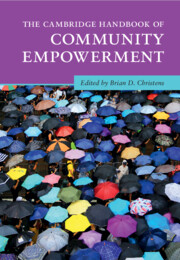Book contents
- The Cambridge Handbook of Community Empowerment
- Cambridge Handbooks in Psychology
- The Cambridge Handbook of Community Empowerment
- Copyright page
- Contents
- Figures
- Tables
- Contributors
- Building Community Power
- Part I Organizing and Activism
- 1 Youth Organizing
- 2 Youth Activism in Postapartheid South Africa
- 3 Domestic Violence and Community Organizing in India
- 4 Congregation-Based Community Organizing
- 5 Immigrant Organizing and Activism
- 6 Online Racial Justice Advocacy
- Part II Participatory Governance
- Part III Civil Society and Coalitions
- Part IV Enterprise
- Part V Participatory and Community Arts
- Part VI Education and Engaged Research
- Contributor Details
- Index
- References
1 - Youth Organizing
from Part I - Organizing and Activism
Published online by Cambridge University Press: 18 April 2024
- The Cambridge Handbook of Community Empowerment
- Cambridge Handbooks in Psychology
- The Cambridge Handbook of Community Empowerment
- Copyright page
- Contents
- Figures
- Tables
- Contributors
- Building Community Power
- Part I Organizing and Activism
- 1 Youth Organizing
- 2 Youth Activism in Postapartheid South Africa
- 3 Domestic Violence and Community Organizing in India
- 4 Congregation-Based Community Organizing
- 5 Immigrant Organizing and Activism
- 6 Online Racial Justice Advocacy
- Part II Participatory Governance
- Part III Civil Society and Coalitions
- Part IV Enterprise
- Part V Participatory and Community Arts
- Part VI Education and Engaged Research
- Contributor Details
- Index
- References
Summary
The field of youth organizing emerged in the 1990s, as nonprofit organizations began engaging low-income youth of color, aged thirteen to nineteen, in political education and community organizing work while also providing developmental supports, such as academic tutoring and mental health resources. Over the last thirty years, the field has expanded rapidly. This chapter discusses the unique features of youth organizing and identifies trends in the field, including the growth in different kinds of youth organizing groups, the rise of coalitions, and changes in the demographic makeup of participants. It then presents a case description of a long-standing youth organizing group, Asian/Pacific Islander Youth Promoting Advocacy and Leadership (AYPAL), based in Oakland, California. Next, the chapter reviews the literature addressing how youth organizing promotes the psychological empowerment of its participants and builds community power situationally, institutionally, and systemically. It concludes by highlighting the implications of this research and suggesting opportunities for future scholarship.
Keywords
- Type
- Chapter
- Information
- The Cambridge Handbook of Community Empowerment , pp. 35 - 58Publisher: Cambridge University PressPrint publication year: 2024

